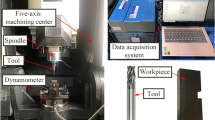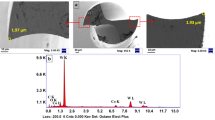Abstract
It is indispensable to explore the appropriate level of surface residual stress to enhance the wear resistance of coated tools. TiAlSiN-coated carbide tools with dissimilar surface residual compressive stresses (− 300 ~ − 600 MPa) are acquired via micro-sandblasting, which are used in the high-speed sliding friction experiments and turning experiments. The influence of residual stress on the sliding wear and cutting wear performance of TiAlSiN coated tools is investigated. The results show that with the improvement of surface residual compressive stress (absolute value), the friction coefficient and wear rate are reduced. The sliding wear resistance of the coated tool is enhanced. In addition, the cutting performance of the tool is also improved with the increase of residual compressive stress (absolute value). However, the excessive surface residual compressive stresses (absolute value) can lead to severe coating peeling, which in turn impairs the capability of wear resistance. The TiAlSiN-coated carbide tool with the stress of − 500 MPa presents the best wear resistance in the high-speed sliding wear and cutting wear process.














Similar content being viewed by others
Data availability
The datasets used or analyzed during the current study are available from the corresponding author on reasonable request.
References
Kumar TS, Prabu SB, Manivasagam G, Padmanabhan KA (2014) Comparison of TiAlN, AlCrN, and AlCrN/TiAlN coatings for cutting-tool applications. Int J Miner Metall Mater 21(08):796–805. https://doi.org/10.1007/s12613-014-0973-y
Li AH, Zhao J, Zang J, Zheng W (2016) Design and simulation of thermal residual stresses of coatings on wc-co cemented carbide cutting tool substrate. J Mech Sci Technol 30(8):3777–3783. https://doi.org/10.1007/s12206-016-0430-0
Zhao JF, Liu ZQ, Wang B, Hu JR, Wan Y (2021) Tool coating effects on cutting temperature during metal cutting processes: comprehensive review and future research directions. Mech Syst Signal Process 150(7–8):107302. https://doi.org/10.1016/j.ymssp.2020.107302
Chowdhury MSI, Bose B, Yamamoto K, Shuster LS, Paiva J, Fox-Rabinovich GS, Veldhuis SC (2020) Wear performance investigation of PVD coated and uncoated carbide tools during high-speed machining of TiAl6V4 aerospace alloy. Wear 446–447:203168. https://doi.org/10.1016/j.wear.2019.203168
Cui XB, Guo YH, Guo JX, Ming PM (2020) Bio-inspired design of cleaner interrupted turning and its effects on specific cutting energy and harmful gas emission. J Clean Prod 271:122354. https://doi.org/10.1016/j.jclepro.2020.122354
Cui XB, Sun NN, Guo JX, Ma JJ, Ming PM (2022) Green multi-biomimetic spontaneous oil-transport microstructure and its effects on energy consumption in sustainable intermittent cutting. J Clean Prod 367:133035. https://doi.org/10.1016/j.jclepro.2022.133035
Cui XB, Duan SQ, Guo JX, Ming PM (2022) Bionic multifunctional surface microstructure for efficient improvement of tool performance in green interrupted hard cutting. J Mater Process Technol 305:117587. https://doi.org/10.1016/j.jmatprotec.2022.117587
Hou M, Mou W, Yan G, Song G, Wu Y, Ji W, Jiang Z, Wang W, Qian C, Cai Z (2020) Effects of different distribution of residual stresses in the depth direction on cutting performance of TiAlN coated WC-10wt%Co tools in milling Ti-6Al-4V. Surf Coat Technol 397:125972. https://doi.org/10.1016/j.surfcoat.2020.125972
Chaus AS, Sitkevich MV, Pokorný P, Sahul M, Haršáni M, Babincová P (2021) Wear resistance and cutting performance of high-speed steel ball nose end mills related to the initial state of tool surface. Wear 472–473:203711. https://doi.org/10.1016/j.wear.2021.203711
Breidenstein B, Denkena B, Vetter J, Richter B (2016) Influence of the residual stress state of coatings on the wear behavior in external turning of AISI 4140 and Ti–6Al–4V. Prod Eng Res Devel 10(2):147–155. https://doi.org/10.1007/s11740-015-0650-7
Bobzin K, Brögelmann T, Maier HJ, Heidenblut T, Kahra C, Carlet M (2021) Influence of residual stresses in hard tool coatings on the cutting performance. J Manuf Process 69:340–350. https://doi.org/10.1016/j.jmapro.2021.08.011
Gonzalo O, Navas VG, Coto B, Bengoetxea I, Gopegi UR, Etxaniz M (2011) Influence of the coating residual stresses on the tool wear. Procedia Eng 19(1):106–111. https://doi.org/10.1016/j.proeng.2011.11.087
Tillmann W, Grisales D, Stangier D, Thomann CA, Debus J, Nienhaus A, Apel D (2020) Residual stresses and tribomechanical behaviour of TiAlN and TiAlCN monolayer and multilayer coatings by DCMS and HiPIMS. Surf Coat Technol 406:126664. https://doi.org/10.1016/j.surfcoat.2020.126664
Maiti AK, Mukhopadhyay N, Raman R (2009) Improving the wear behavior of WC-CoCr-based HVOF coating by surface grinding. J Mater Eng Perform 18:1060. https://doi.org/10.1007/s11665-009-9354-5
Oladijo OP, Luzin V, Maledi NB, Setswalo K, Ntsoane TP, Abe H (2020) Residual stress and wear resistance of HVOF Inconel 625 coating on SS304 steel substrate. J Therm Spray Technol 29(1):1382–1395. https://doi.org/10.1007/s11666-020-01066-x
Özkan D, Alper YM, Szala M, Türküz C, Chocyk D, Tunç C, Göz O, Walczak M, Pasierbiewicz K, Barış YM (2021) Effects of ceramic-based CrN, TiN, and AlCrN interlayers on wear and friction behaviors of AlTiSiN+TiSiN PVD coatings. Ceram Int 47(14):20077–20089. https://doi.org/10.1016/j.ceramint.2021.04.015
Breidenstein B, Denkena B (2013) Significance of residual stress in PVD-coated carbide cutting tools. CIRP Ann Manuf Technol 62(1):67–70. https://doi.org/10.1016/j.cirp.2013.03.101
Yang J, Odén M, Johansson-Jõesaar MP, Llanes L (2014) Grinding effects on surface integrity and mechanical strength of WC-Co cemented carbides. Procedia CIRP 13(1):257–263. https://doi.org/10.1016/j.procir.2014.04.044
Denkena B, Breidenstein B, Wagner L, Wollmann M, Mhaede M (2013) Influence of shot peening and laser ablation on residual stress state and phase composition of cemented carbide cutting inserts. Int J Refract Met Hard Mater 36:85–89. https://doi.org/10.1016/j.ijrmhm.2012.07.005
Nikola K, Eric B, Patrice P, Cyril G, Christoph K, Christian L, Jamasp J, Roland E, Logé, (2017) 3D laser shock peening — a new method for the 3D control of residual stresses in selective laser melting. Mater Des 130:350–356. https://doi.org/10.1016/j.matdes.2017.05.083
Skordaris G, Bouzakis KD, Kotsanis T, Charalampous P, Bouzakis E, Breidenstein B, Bergmann B, Denkena B (2017) Effect of PVD film’s residual stresses on their mechanical properties, brittleness, adhesion, and cutting performance of coated tools. CIRP J Manuf Sci Technol 18:145–151. https://doi.org/10.1016/j.cirpj.2016.11.003
Liu CY, Liu ZQ, Wang B (2018) Modification of surface morphology to enhance tribological properties for CVD coated cutting tools through wet micro-blasting post-process. Ceram Int 44:3430–3439. https://doi.org/10.1016/j.ceramint.2017.11.142
Tanaka S, Shirochi T, Nishizawa H, Metoki K, Miura H, Hara H, Takahashi T (2016) Micro-blasting effect on fracture resistance of PVD-AlTiN coated cemented carbide cutting tools. Surf Coat Technol 308:337–340. https://doi.org/10.1016/j.surfcoat.2016.07.094
Chang K, Zheng G, Cheng X, Xu R, Li Y, Yu Z, Yang X (2021) Surface integrity evolution and wear evolution of the micro-blasted coated tool in high-speed turning of Ti6Al4V. The Int J Adv Manuf Technol 115:603–616. https://doi.org/10.1007/s00170-021-07227-8
Behera GC, Thrinadh J, Datta S (2021) Influence of cutting insert (uncoated and coated carbide) on cutting force, tool-tip temperature, and chip morphology during dry machining of Inconel 825. Mater Today: Proceed 38(5):2664–2670. https://doi.org/10.1016/j.matpr.2020.08.332
Wang QQ, Jin ZJ, Zhao Y, Niu L, Guo J (2021) A comparative study on tool life and wear of uncoated and coated cutting tools in turning of tungsten heavy alloys. Wear 482–483:203929. https://doi.org/10.1016/j.wear.2021.203929
Funding
This work was supported by the Natural Science Foundation of Shandong Province (No. ZR2020ME156, No. ZR2020QE179), the National Natural Science Foundation of China (No. 52075306), 2021 Innovation capability improvement project of scientific and technological small and medium-sized enterprises in Shandong Province (No. 2021TSGC1433), and Shandong Provincial Key Laboratory of Precision Manufacturing and Non-traditional Machining.
Author information
Authors and Affiliations
Contributions
Zhenyu Wu contributed to the conceptualization, methodology, formal analysis, investigation, writing — original draft, and writing — review and editing; Guangming Zheng contributed to the investigation, formal analysis, writing — review and editing, and supervision; Jiwang Yan contributed to the conceptualization and writing — review and editing; Xiang Cheng contributed to the formal analysis and writing — review and editing; Huanbao Liu contributed to the methodology and formal analysis; Xianhai Yang contributed to the investigation and supervision.
Corresponding author
Ethics declarations
Competing interests
The authors declare no competing interests.
Additional information
Publisher's note
Springer Nature remains neutral with regard to jurisdictional claims in published maps and institutional affiliations.
Rights and permissions
Springer Nature or its licensor (e.g. a society or other partner) holds exclusive rights to this article under a publishing agreement with the author(s) or other rightsholder(s); author self-archiving of the accepted manuscript version of this article is solely governed by the terms of such publishing agreement and applicable law.
About this article
Cite this article
Wu, Z., Zheng, G., Yan, J. et al. Effect of TiAlSiN coating residual stress on its sliding wear and cutting wear performance. Int J Adv Manuf Technol 123, 3885–3900 (2022). https://doi.org/10.1007/s00170-022-10508-5
Received:
Accepted:
Published:
Issue Date:
DOI: https://doi.org/10.1007/s00170-022-10508-5




